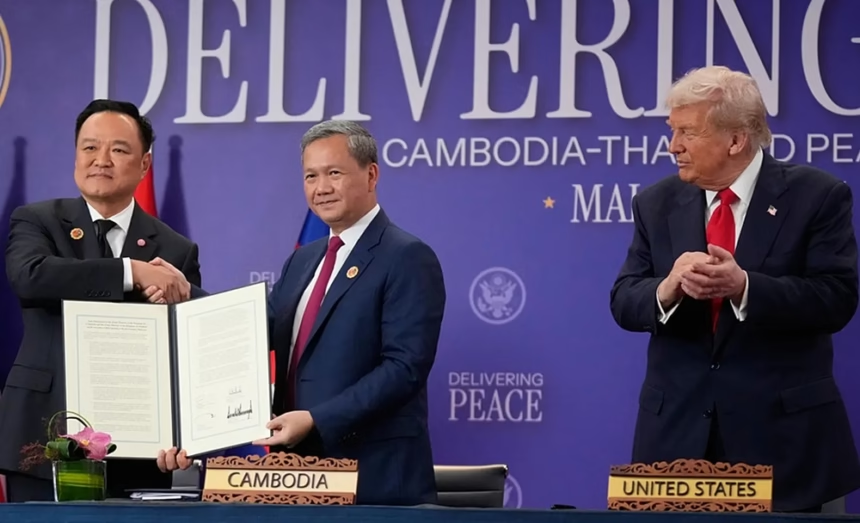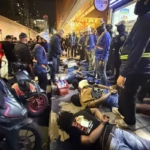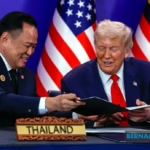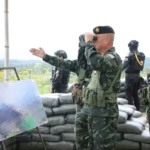KUALA LUMPUR – Under bright afternoon light at the 47th ASEAN Summit, U.S. President Donald J. Trump looked on as Thailand and Cambodia signed a joint declaration to end decades of border friction that flared into lethal clashes earlier this year.
The signing, also witnessed by Malaysian Prime Minister Anwar Ibrahim, signals a fresh push for lasting calm between the neighbours and highlights Washington’s renewed diplomatic clout in Southeast Asia.
Cautious hope filled a chandeliered hall at the city’s convention centre. Thai Prime Minister Anutin Charnvirakul and Cambodian Prime Minister Hun Manet shared a firm handshake, faces set with the weight of the moment, while Trump smiled for the cameras.
“This is what strong leaders do, make peace, not war,” he told reporters, thumbs raised. “I told these two gentlemen, no more fighting or no more deals. And look what happened, peace.”
From Border Flashes to a Truce: The Spark and the Blaze
The path to peace ran through fear and brinkmanship. Trouble reignited on 28 May, when a brief clash in the Emerald Triangle, where Thailand, Cambodia and Laos meet, left a Cambodian soldier dead. A patrol mix‑up soon spiralled into a full crisis.
By June, Cambodia had barred Thai fruits, soap operas and fuel, while Thailand closed seven crossings, trapping travellers and traders. Nationalist calls grew louder. Crowds in Phnom Penh waved flags and asked the ICJ to step in. In Bangkok, rallies urged the defence of historic temple sites, including Preah Vihear, awarded to Cambodia by the World Court in 1962, yet still sensitive.
The explosion came on 24 July. Artillery shook the Dangrek Mountains, rockets lit the sky, and Thai F‑16s struck back. Five days of fighting left at least 40 people dead, both soldiers and civilians, and forced more than 270,000 people from their homes. Mine-injured Thai troops. Snipers lurked among temple stones.
Trump stepped in on 26 July, the third day of fighting. He phoned both leaders and posted on Truth Social: “I am calling the Acting Prime Minister of Thailand right now to request a Ceasefire, and END to the War.” He added, “We happen to be dealing on Trade with both Countries, but do not want to make any Deal if they are fighting, and I have told them so!” It was classic Trump, blunt and transactional.
The push worked. Hours later, with Malaysian mediation in Putrajaya, an immediate and unconditional truce began at midnight on 28 July. Heavy weapons pulled back, with ASEAN observers on watch. Trump, after warning of 100 percent tariffs for holdouts, claimed the role of dealmaker. Cambodia even put its name forward for a Nobel Peace Prize, a nod to the Abraham Accords. “He is not just about business, he is about building bridges,” Hun Manet said after the signing.
Today’s declaration goes further. The four‑page text renews support for the Joint Boundary Commission, bans provocations, and sets steps for de‑escalation. Thailand will free 18 detained Cambodian soldiers as a goodwill gesture. Both sides will restart trade in select zones by November.
Fencing will be installed in areas without dispute, and provincial leaders will coordinate on encroachment cases. “This is trust in practice,” said Thai Defence Minister Natthaphon Narkphanit, after a week of meetings with Cambodian counterparts. Skeptics still worry. Full demarcation remains unfinished, and the 1907 Franco‑Siamese maps still cast a long shadow.
Trump’s Play: Peace Tied to Trade
Few contest Trump’s impact. His July calls quieted the guns, but the bigger move was linking calm to commerce. As ASEAN talks dragged on, he held out the prospect of U.S. trade deals, while warning of tariffs if fighting resumed. “End the war, or kiss your exports goodbye,” he reportedly told Anutin and Manet. It was a hard bargain that fused America First politics with regional strategy.
The result landed today. Trump signed reciprocal trade deals with Cambodia and Malaysia, plus a framework with Thailand, part of a rapid Asia swing aimed at rare earth supply chains. For Thailand, the stakes were clear. The U.S. is its top export market, supporting jobs from Bangkok’s factories to rice fields in Chiang Rai.
Trade with the U.S. underpins Thailand’s economy, reaching 74.48 billion dollars in 2024, with 54.96 billion in exports. Thai shipments range from electronics and hard drives, to rubber for tyres, to gems and seafood like frozen shrimp. The U.S. posted a surplus of more than 20 billion dollars last year, a win for Thai workers but a concern for Trump’s deficit watchers.
A new framework, announced by the White House yesterday, resets the balance. Thailand will cut tariffs to zero on 99 percent of U.S. goods, including industrial machinery, vehicles, pharmaceuticals and ethanol. In return, the U.S. will cap tariffs at 19 percent on Thai exports, far below the threatened 60 percent, with zero rates for aligned items such as critical minerals. There are non‑tariff shifts too. Thailand will recognize U.S. FDA approvals for medicines and cars that meet U.S. safety rules, ease meat imports, and drop a quirky customs reward scheme that upset exporters.
Critics complain the balance still favours Washington. Beijing is watching, as these deals may route around its supply chains. Yet along the Mekong, where Thai and Khmer traditions mingle, today’s ink feels like a reset. As Trump flew on to Beijing for talks with Xi, Anutin and Manet raised a quiet glass. “To neighbours, not enemies,” Manet said.












